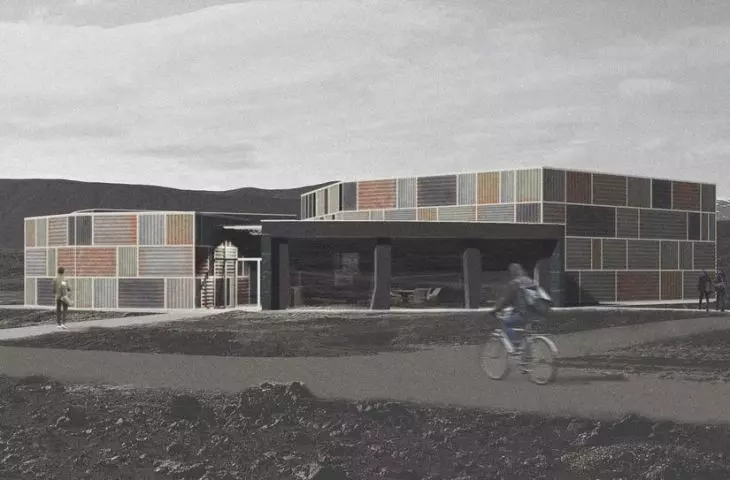A {tag:student} from the Faculty of Architecture at the Warsaw University of Technology also participated in the international competition for a movie pavilion in Iceland—Iceland Movie Pavilion. His design, a distinctive, „cracked”, one-story building—Cracked Movie Pavilion taking into account the most important viewing directions, was shortlisted for the competition.
The Iceland Movie Pavilion competition organized by the Bulidner platform sought the best designs for a movie pavilion that could be built in northern Iceland. The ideas were to reflect the essence of Icelandic cinema, its distinctive style and unique history, with the centerpiece to be a cinema that could accommodate up to fifty viewers. In addition to the cinema, the building was to include a multipurpose space, a café/bar, a gallery and a reception area. The eco-friendly and energy-efficient building was to have a cost-effective design, resistant to Icelandic climatic conditions.
Interior of the film pavilion, foyer
© Antoni Soszyński
The competition awarded three grand prizes, honorable mentions and announced the shortlist. We wrote about the full jury and the awards as part of an article about the Grjótagjá Trail project, by a team of Warsaw University of Technology students consisting of: Maja Dziwok, Alexandra Dectot. On the other hand, the shortlist for the competition included Antoni Soszynski's project Cracked Movie Pavilion, also made as part of the Architectural Design class under the direction of Prof. Elżbieta Dagna Ryńska, Dr. Michal Pierzchalski and Dr. Mateusz Płoszaj-Mazurek at the Warsaw University of Technology.
Cracked Movie Pavilion project, axonometry
© Antoni Soszyński
"cracked" pavilion
My Cracked Movie Pavilion project is closely related to its location. The most attractive rock or natural formations—Grjótagjá Caves, Hverfjall Crater, Krafla Volcano and Lake Myvatn formed the directions marking the division of the development. The cracks continue both inside—corridors and foyers at the intersection of paths—and outside, as paths leaving the building. The volumes are divided into two types—those without windows, which are on a polygonal plan, and those with huge glazing with round ends, the author explains.
film pavilion, projection
© Antoni Soszynski
The materials the designer decided on are local volcanic stone used in the form of blocks and unevenly chiseled columns supporting the glazed roof. The roof is covered with turf, reminiscent of traditional Icelandic architecture, and recycled corrugated sheet metal. Its different shades give the pavilion an original expression.
The facade is covered with corrugated sheet metal
© Antoni Soszyński
cinema and cafe in Iceland
The design of the cinema hall was made by a PW student with viewers in mind—viewing angles are optimized, the interior walls are soundproofed, and everything is adapted to the needs of people with disabilities. Several corridors lead to the foyer, which is the center of the facility. The corridors, in turn, connect to outdoor paths that reach the border of the plot and are topped with binoculars, allowing observation of natural attractions located near the pavilion.
Idea diagram and paths leading to tourist attractions
© Antoni Soszynski
The author has also designed a multifunctional interior for the café. It can be arranged as a simple dining space, or tables can be removed and an exhibition set up there with a view of the Icelandic landscape serving as a backdrop for the exhibits. The bistro is supported by kitchen facilities, so hot meals are also served here. Social rooms have been provided for employees.
The corrugated metal facade gives the building character
© Antoni Soszynski
Antoni Soszynski also took into account the possibility of extending the path to the Grjótagjá Caves—the main entrance to the pavilion is on this axis, and such a procedure will connect these two tourist attractions.









































